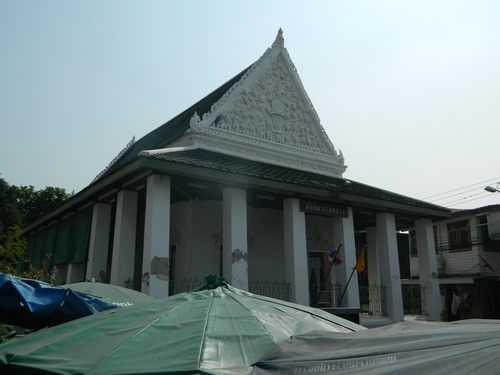ค้นหางานศิลปกรรม
ฐานข้อมูลศิลปกรรมในเอเชียตะวันออกเฉียงใต้
สถาปัตยกรรมมัสยิดต้นสน
มัสยิดต้นสนมีอาคารทรงสี่เหลี่ยมผืนผ้า หลังคาทรงจั่วมุงกระเบื้อง มีลูกกรงโปร่งอยู่ตลอดแนวหลังคาและกันสาดยื่นออกมา ผนังอาคารเป็นสีน้ำตาลมีการตกแต่งผนังด้านนอกด้วยลายปูนปั้นลายพันธุ์พฤกษาและเรขาคณิต กรอบประตูและหน้าต่างมีลักษณะคล้ายเกือกม้า ตรงกลางมีมุขยื่นออกมามีโดมทรงกระบอกอยู่ด้านบน ฐานโดมมีซี่คาดโดยรอบ ด้านในโดมทำเป็นโครงสร้างแบบรวงผึ้ง ภายในเป็นสถานที่ทำละหมาด มีมิร์หรอบเป็นชุดเดียวกับกำแพงกิบลัต ตัวมิร์หรอบทำจากหินอ่อนมีการเจาะช่องโค้งตกแต่งด้วยงานปูนปั้นลายพันธุ์พฤกษาและข้อความจากคัมภีร์อัลกุรอาน มีมิมบัรตั้งอยู่ด้านข้าง เพดานมีโคมไฟหลายชิ้น หนึ่งในนั้นคือโคมไฟพระราชทานในงานพระบรมศพของพระบาทสมเด็จพระจุลจอมเกล้าเจ้าอยู่หัว ซึ่งรัชกาลที่ 5 ได้พระราชทานให้มัสยิดต้นสน
สถาปัตยกรรมมัสยิดบางหลวง
มัสยิดแห่งนี้มีผังพื้นเป็นสี่เหลี่ยมผืนผ้า มีหลังคาพาไลยื่นออกมาข้างหน้า ด้านอื่นเป็นหลังคาปีกนก มีเสารองรับหลังคา บันไดทางขึ้นอยู่ทางทิศเหนือและใต้ของพาไลด้านหน้า หลังคาทรงจั่วมุงกระเบื้องว่าวสีเขียว หน้าบันปูนปนั้นผสมผสานศิลปะไทย ตะวันตก และจีน ภายในห้องละหมาดมีมิมบัรและมิห์รอบที่สร้างขึ้นใหม่โดยเจ้าสัวพุกในสมัยรัชกาลที่ 6 แทนที่ของเดิมที่ชำรุดลง มิห์รอบเป็นซุ้มก่ออิฐถือปูนทรงสามยอดประดับกระจกสี สันนิษฐานว่ามีที่มาจากซุ้มประตูวัดอนงคารามมีการแกะสลักอักษรอาหรับเป็นพระนามขององค์อัลลอฮ์และมีโองการสำคัญติดตั้งอยู่ภายในซุ้ม
สถาปัตยกรรมจันทิเบดังดาลาม
สถาปัตยกรรมของจันทิแห่งนี้ ประกอบด้วยครรภคฤหะและมณฑป ครรภคฤหะมีลักษณะเป็นห้องสี่เหลี่ยมขนาดเล็กที่มีประตูทางเข้าเพียงทางเดียว ผนังก่ออิฐ โดยรอบมีร่องรอยของทางประทักษิณที่มีหลุมเสาสำหรับเสียบหลังคาเครื่องไม้ ด้านหน้ามีมณฑปโปร่งซึ่งมีหลุมเสาสำหรับเสียบเสารองรับหลังคาเครื่องไม้มุงกระเบื้องเช่นเดียวกัน จันทิดังกล่าวแม้จะไม่มีความซับซ้อนนักเมื่อเทียบกับศิลปะชวา แต่ก็สามารถเป็นหลักฐานถึงการเข้าของสถาปัตยกรรมอินเดียและชวาในคาบสมุทรมลายูสมัยโบราณได้เป็นอย่างดี
สถาปัตยกรรมมัสยิดซาฮีร์
มัสยิดซาฮีร์ เป็นมัสยิดที่ผสมผสานกับระหว่างศิลปกรรมอิสลามหลายสกุล โดยโดมประธานเป็นโดมที่มีกลีบดอกไม้คว่ำอยู่ด้านบนตามแบบศิลปะโมกุลของอินเดีย แต่มีอาร์คที่มีเสากลมเล็กและประกอบด้วยวงโค้งเล็กๆหลายวงตามแบบศิลปะมัวร์ของสเปน การผสมผสานกันระหว่างศิลปะโมกุลและศิลปะมัวร์ดูเหมือนจะเป็นที่นิยมในศิลปะสมัยอาณานิคมอังกฤษที่พยายามเอาลักษณะเด่นของศิลปะอิสลามในพื้นทีต่างๆมาผสมผสานกัน
สถาปัตยกรรมมัสยิดกปิตันกลิง
มัสยิดกปิตันกลิง เป็นมัสยิดที่ได้รับแรงบันดาลใจจากศิลปะโมกุลของอินเดียเป็นหลัก ทั้งการจัดวางโดมสามโดมเรียงกัน โดยโดมประธานเป็นโดมที่มีกลีบดอกไม้คว่ำอยู่ด้านบน การใช้แผงด้านหน้า (pishtaq) เป็นรูปอาร์คโค้งในกรอบสี่เหลี่ยม การใช้หอคอยซึ่งมีฉัตรี (Chhatri) ระดับอยู่ด้านบน ทั้งหมดนี้เป็นศิลปะโมกุลที่สถาปนิกอังกฤษได้นำเข้ามาเผยแพร่ในมาเลเซีย เป็นไปได้ที่สถาปนิกผู้ออกแบบมัสยิดพยายามที่จะแสดงความเป็นอินเดียให้มากที่สุดเพื่อให้ตอบรับกับประวัติที่ว่าผู้สร้างมัสยิดคนแรกเป็นชาวอินเดีย
ประติมากรรมหอคอยของมัสยิดกปิตันกลิง
มัสยิดกปิตันกลิง เป็นมัสยิดที่ได้รับแรงบันดาลใจจากศิลปะโมกุลของอินเดียเป็นหลัก เป็นไปได้ที่สถาปนิกผู้ออกแบบมัสยิดพยายามที่จะแสดงความเป็นอินเดียให้มากที่สุดเพื่อให้ตอบรับกับประวัติที่ว่าผู้สร้างมัสยิดคนแรกเป็นชาวอินเดียด้วยเหตุนี้ หอคอยซึ่งแสดงอิทธิพลศิลปะโมกุลอย่างชัดเจน เช่น หอคอยทรงแปดเหลี่ยมที่ประกอบด้วยระเบียงหลายชั้น ด้านบนสุดเป็นฉัตรี (Chhatri) ซึ่งหมายถึงอาคารแปดเหลี่ยมที่มีเสาแปดต้นรอบรับโดมขนาดเล็ก
สถาปัตยกรรมมัสยิดสุลต่าน
อิทธิพลแบบอินเดียและมัวร์ที่ปรากฏในมัสยิดแห่งนี้สามารถเปรียบเทียบได้กับมัสยิดหลายหลังในมาเลเซียซึ่งสร้างขึ้นโดยสถาปนิกชาวอังกฤษเช่นเดียวกัน ลักษณะแบบอินเดียนั้น ได้แก่ลักษณะของโดมซึ่งมีคอทรงกระบอก และการมีกลีบดอกไม้ประดับไปด้านบนโม รวมถึงระเบียบการประดับฉัตรีไว้ที่ด้านบนหอคอย อย่างไรก็ตาม อาร์ควงโค้งหลายวงต่อเนื่องกันที่ปรากฏในส่วนกลางของมัสยิด กลับแสดงให้เห็นอิทธิพลแบบสเปน
สถาปัตยกรรมมัสยิดฮัญญะฮฺ ฟาติมะฮฺ
เป็นมัสยิดที่น่าสนใจมากเนื่องจากผสมผสานระหว่างศิลปะอินเดียแบบโมกุลและศิลปะยุโรป โดยเฉพาะหอคอยของมัสยิดซึ่งสร้างเป็นแบบตะวันตก คือเป็นหอคอยแปดเหลี่ยมที่มียอดเป็นทรงกระโจมแหลมคล้ายคลึงกับหอคอยของโบสถ์ในศาสนาคริสต์เป็นอย่างมาก ทั้งหมดนี้เกิดขึ้นจากการออกแบบของสถาปนิกชาวอังกฤษ



